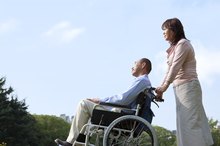Symptoms of Low Muscle Tone
Muscle tone refers to passive tension of muscles when they are relaxed, and its associated with firmness, strength and definition. There are hundreds of muscles in the human body. However, muscle tone is generally attributed to the class of muscles that are connected to your skeleton's bones and are responsible for everyday movement, called skeletal muscles. Skeletal muscles with low muscle tone exhibit numerous symptoms, and can be attributed to various causes.
Symptoms
Low or decreased muscle tone -- also called hypotonia -- can occur in adults and children. According to Scotland's National Health Services, some of the symptoms of hypotonia in children include having little or no head control; being unable to feed themselves; and developmental delays in sitting up, crawling or walking. NIH's National Institute of Neurological Disorders and Stroke reports that in adults or children, other symptoms may include general mobility and posture issues, loose ligaments and joints (laxity), and poor reflexes. Low muscle tone that's specifically linked to senior adults and aging may not show severe symptoms, but a gradual loss of strength and increased weakness that could interfere with performing basic daily tasks may occur, according to Valley Family Medical.
Causes
Diseases Similar to ALS
Learn More
While some causes for hypotonia are unknown, generally low muscle tone may be congenital or acquired. If it's congenital, it may be due to genetic, muscular or chromosomal disorders, such as Down's syndrome, muscular dystrophy or Tay-Sachs disease. Acquired hypotonia may be due to brain, spinal cord, nerve or muscle trauma/injury. Also, as NIH's The National Institute of Arthritis and Musculoskeletal and Skin Diseases reports, lack of physical activity may cause muscle wasting or atrophy, which ultimately equates to a loss of muscle tone.
Additionally, there is a loss of muscle mass, strength and tone that occurs with aging called sarcopenia. While a gradual loss of muscle tone can begin as early as in your 30s, the marked symptoms of sarcopenia usually appear in men and women after age 65, and are characterized by a 20 to 40 percent average decrease in muscle strength. As the American Physiological Society reports, there are several possible causes, ranging from hormonal to neuromuscular factors.
Exercise
Treatment for loss of muscle tone will vary with its underlying cause; however, treatment usually includes some form of rehabilitative therapy. For less severe, acquired cases of hypotonia, according to the British Broadcast Corporation, muscle tone can be developed by consistent exercise. The U.S. Centers for Disease Control and Prevention (CDC) reports that to get the maximum health benefit of physical activity, adults need at least 150 minutes each week of moderate aerobic activity, and two days of muscle-strengthening activities that work all of the main muscle groups. The CDC also advises that children and adolescents need at lease 60 minutes of daily physical activity.
Nutrition
Importance of Muscular Strength
Learn More
Kelly Dorfman, a nutritionist and co-founder of Delayed Development Resources, states that while many neurologists attribute poor muscle tone in children to neurological imbalances, nutrition is a key component to low muscle tone. Dorfman cites that low levels of carnitine -- a type of amino acid -- are linked to poor muscle tone in children. Co-enzyme Q-10, B-vitamins and vitamin E supplements, as well as avoiding concentrated sugars and increasing protein intake, may assist in developing muscle tone, according to Dorfman. Muscle Prodigy.com reports that developing good muscle tone is also facilitated through balanced nutrition for adults. Some of the main foods that contain the nutrients needed for healthy muscles includes vegetables, fruits, whole-wheat products, lean meats and low-fat dairy products.
Related Articles
References
- Innerbody.com: Muscular System
- The Free Dictionary.com: Muscle Tone
- Neurosoma.com: Muscle Tone
- University of Maryland Medical Center: Hypotonia
- National Health Services: Hypotonia
- NIH National Institute of Neurological Disorders and Stroke: Hypotonia Information Page
- Valley Family Medical: Sarcopenia
- NIH National Institute of Arthritis and Musculoskeletal and Skin Diseases: Healthy Muscle Matters
- Oxford Journals/ Journals of Gerontology: Sarcopenia - Causes, Consequences, and Preventions.
- American Physiological Society; Aging and Sarcopenia
Resources
- BBC: Physical Education: Muscle Tone and Posture
- Centers for Disease Control and Prevention: How Much Physical Activity Do Adults Need?
- Centers for Disease Control and Prevention: How Much Physical Activity Do Children Need?
- Developmental Delay Resources: How Nutrition Impacts Muscle Tone
- Muscle Prodigy.com: How to Successfully Develop Muscle Tone
- Mayo Clinic: Stay Active to Slow Muscle Loss That Comes with Aging
Writer Bio
Andrea Sigust began writing professionally in 1994, authoring user-friendly manuals, reference guides and information sheets while working at a hospital. After years of working in industries ranging from health care to telecommunications, Sigust became a writer. She specializes in the sciences and holds a Bachelor of Science in journalism from the University of Maryland.









